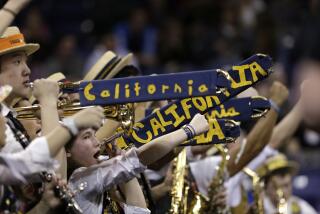A Higher Name in Higher Education
- Share via
What’s in a name? Plenty, according to the folks at the Claremont Graduate School. That’s why they’ve just changed theirs.
Everyone at the nationally renowned institution 35 miles east of Los Angeles knows the pitfalls. A new name could alienate alumni, making them feel less connected to--and generous toward--the 72-year-old school. Some faculty members worry that a name change will strip away some of the school’s intimate character. Then there’s the stationery problem--every official sheet of paper, every envelope and every memo pad must be replaced.
But the board of directors wants to attract a broader range of students and faculty. And although it may sound like less of a substantive change than a cosmetic one, they believe a new name will make that happen.
So the school became Claremont Graduate University on Tuesday.
“Graduate ‘school’ sounds intimate but it also sounds narrow,” said Michael J. Johnston, the board chairman. “ ‘University’ is a much more apt and descriptive word.”
Claremont is not the only institution to seek new vigor by fiddling with its nomenclature. According to the Chronicle of Higher Education, about 35 public and private colleges have elevated themselves to university status since 1993. Often, the new name is unaccompanied by dramatic changes in curriculum or faculty, leading author Anne Matthews to dub the practice “a free overnight upgrade.”
“Colleges usually stress teaching, and universities research, but name inflation only takes one press release,” Matthews wrote in her recent book, “Bright College Years: Inside the American Campus Today.”
Some higher education leaders defend name changes as legitimate, even necessary. At Claremont Graduate University, for example, officials say the new name gives a more accurate picture of the institution, which offers master’s and doctoral degrees in 19 academic fields.
“No other independent graduate institution in the country provides [that] breadth of graduate degree programs,” said its president, John D. Maguire.
Other schools have become universities in the hopes of eliminating confusion with two-year colleges that have dropped “community” from their names. Some institutions hope the grander title will help boost fund-raising. Others, such as Oregon’s regional colleges--which became universities this April--say the name change makes them more attractive to international students.
Jerry Blanche, director of university relations at Eastern Oregon University (formerly Eastern Oregon State College), said some Asian students had trouble convincing sponsors at home that a college education had merit.
“We would have some students come for two years and then transfer out so they could graduate from a university,” Blanche said, adding that in Asia, people “tend to give more credibility to the university name.” The change, he said, was “a matter of currency--of getting ourselves up to date.”
Still, some newly minted universities admit that their new titles reflect not so much what they are as what they hope to be. Though traditionally the word “university” has implied research activity and scholarship, today the term is used to describe all kinds of institutions.
For example, Kentucky’s Campbellsville University, which changed its name in 1994, has no doctoral programs and only two master’s programs, although there are plans to add half a dozen more in a few years. And in Kansas, the Haskell Indian Nation’s University (originally Haskell Indian Junior College), still describes itself as primarily a two-year institution.
Last year, when 13 public four-year colleges in Georgia became “regional and state universities,” the new name came with no increase in state funding and no promise of new programs. Doctoral degrees are still offered only at the state’s four research universities--a division of labor that mimics that of the University of California and the California State University.
The changeover can bring headaches. When the Montana Board of Regents mandated that its state colleges affiliate with two state universities in 1994, officials found it difficult to create a single logo to appear on all letterheads. And suddenly, there was confusion about abbreviating--where there had once been a single MSUB (Montana State University Bozeman) now there was a second (in Billings).
“Which campus are you referring to?” became a familiar refrain, according to Lynn Hamilton, director of university relations at a third campus, MSU Northern. At Hamilton’s school, which for 65 years had been called Northern Montana College--or NMC--officials have tried to prevent a loss of identity by keeping the old fight song.
“It still says, ‘For we will cheer, boys, cheer for NMC!’ Hamilton said. “They haven’t tried to change that yet.”
More to Read
Sign up for Essential California
The most important California stories and recommendations in your inbox every morning.
You may occasionally receive promotional content from the Los Angeles Times.













